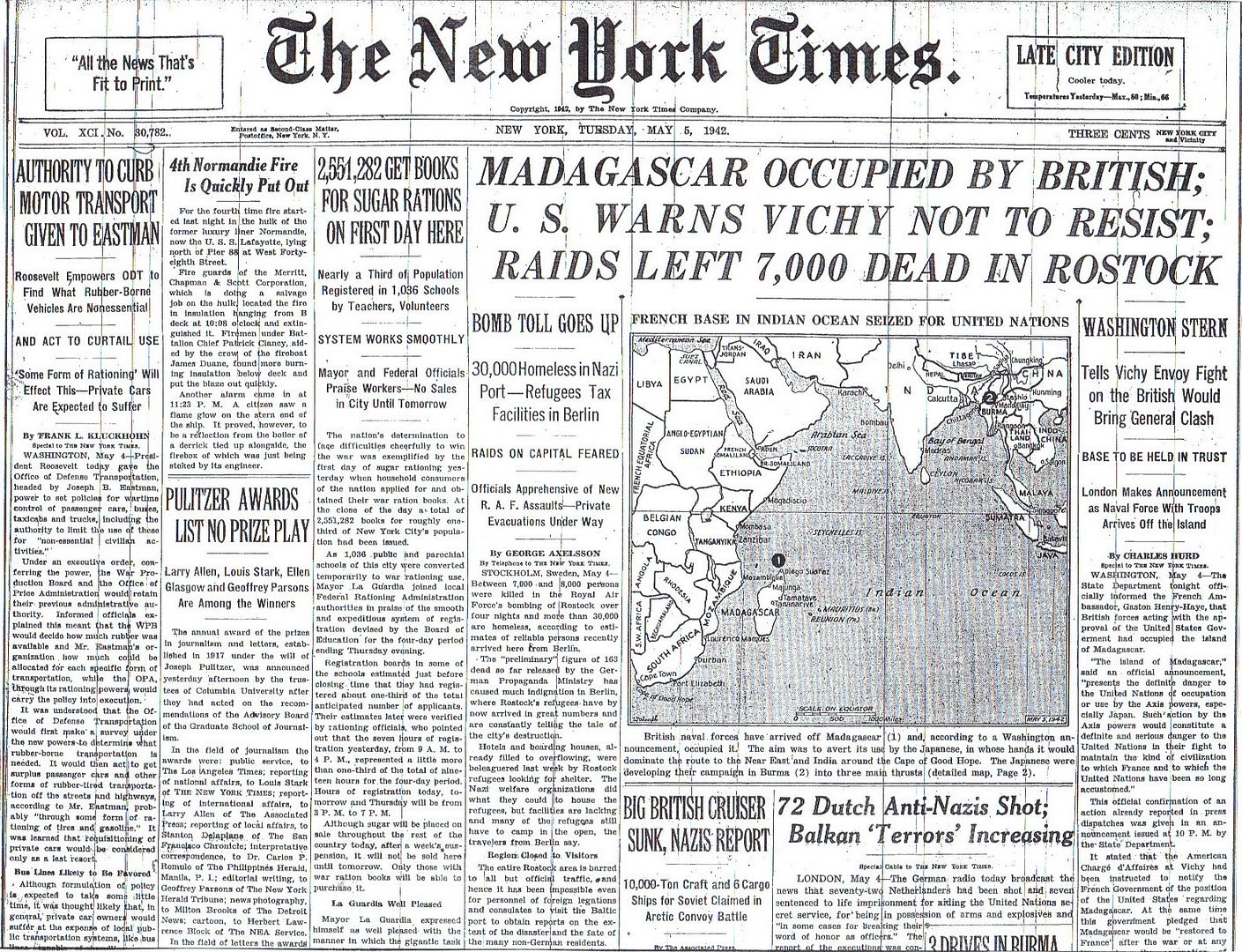
Posted on 05/05/2012 4:56:12 AM PDT by Homer_J_Simpson

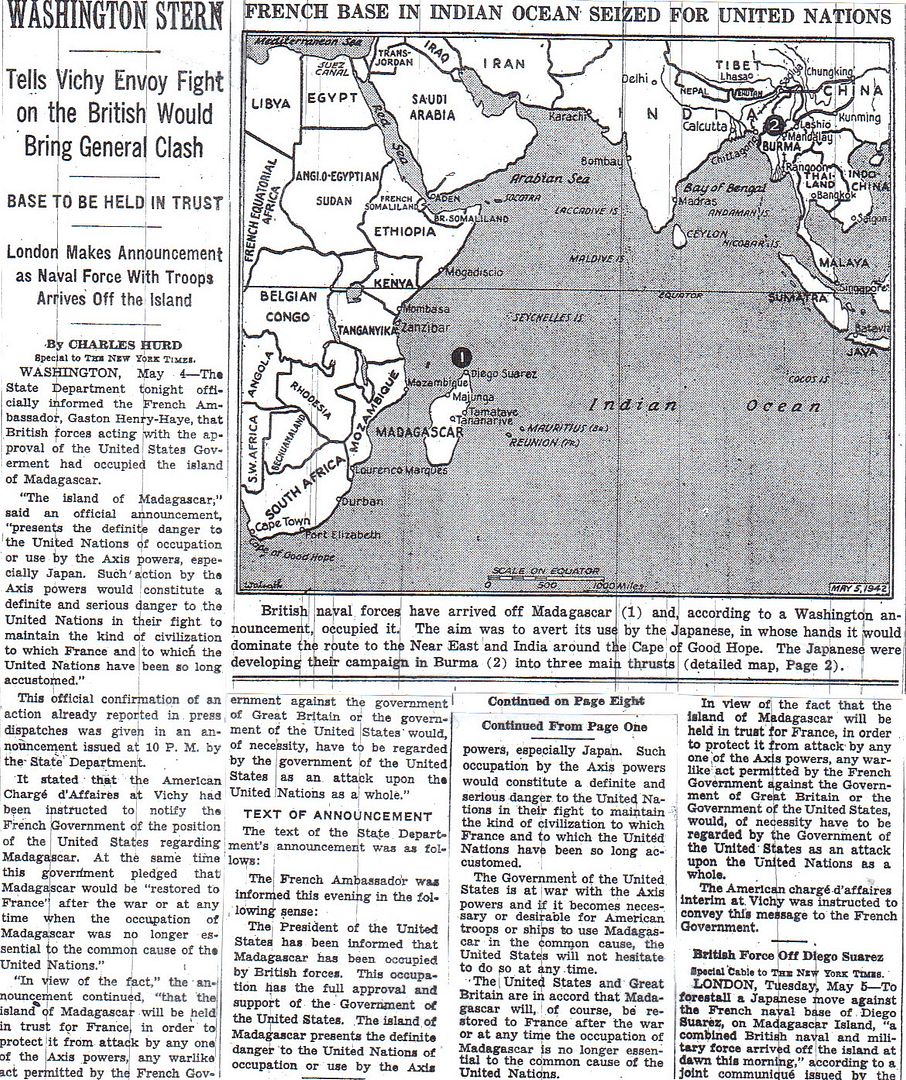
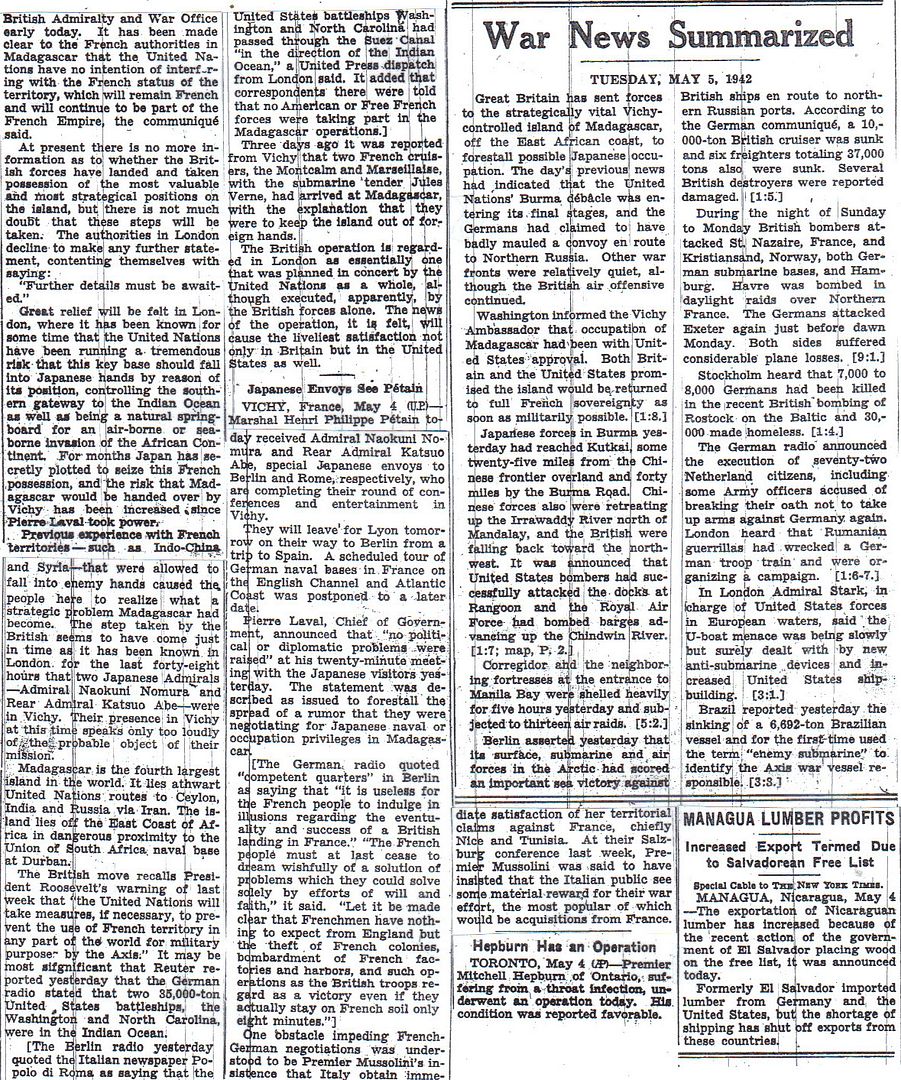

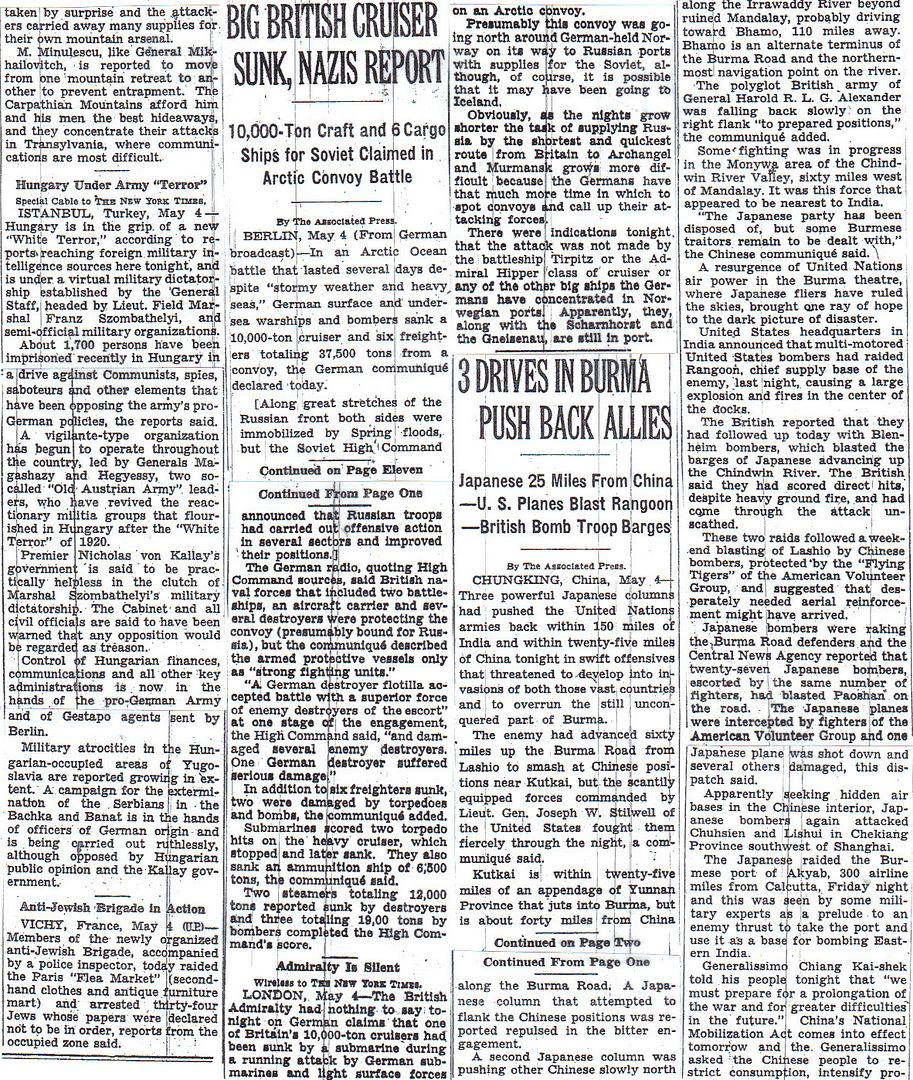
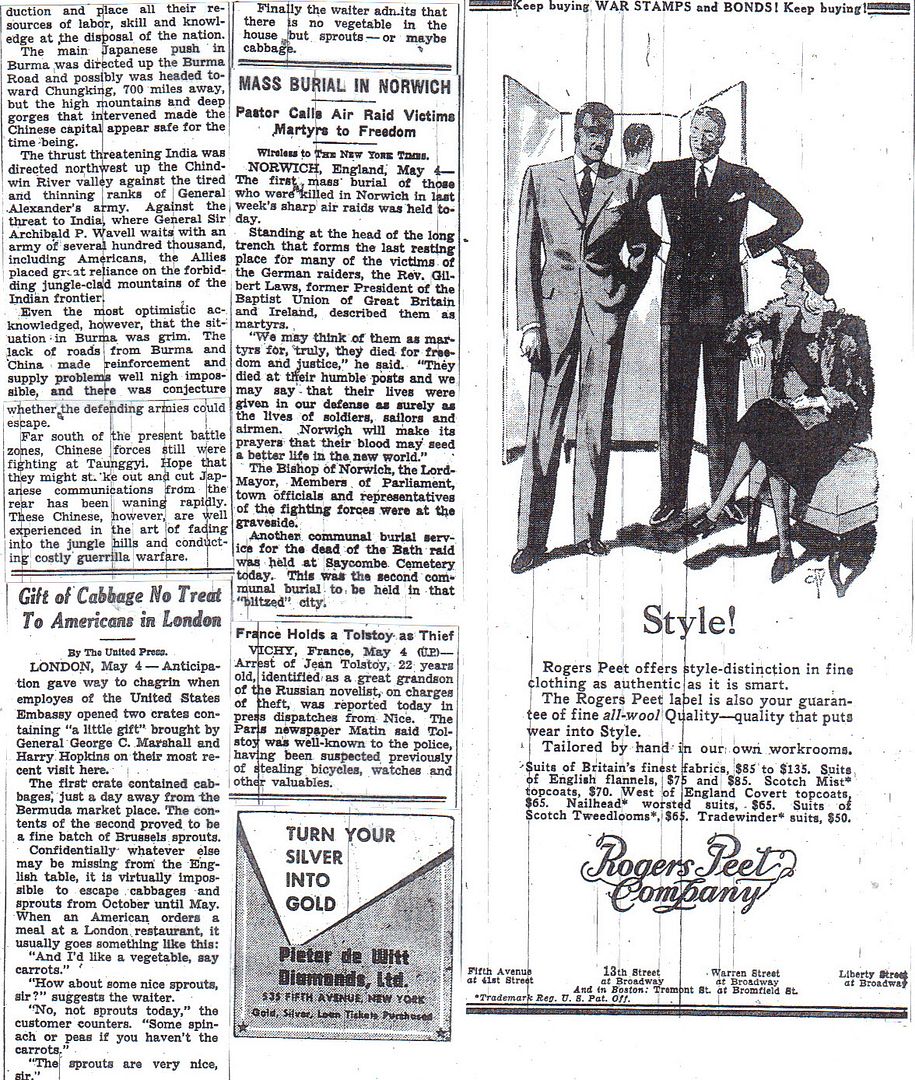


http://www.onwar.com/chrono/1942/may42/f05may42.htm
British invade Vichy French Madagascar
Tuesday, May 5, 1942 www.onwar.com
British forces invading Madagascar [photo at link]
In Madagascar... The British land forces near Diego Suarez, supported by a battleship and two carriers.
In the Coral Sea... Japanese Admiral Takagi’s carriers enter the Coral Sea. American Admiral Fletcher’s TF17 is there refueling, but the Japanese do not find it.
From Washington... Support for the British action in Madagascar indicates a change in US policy which has been sensitive to Vichy France’s concerns. The American support mentions that the British action is essential to guard against Axis use of the island, “especially Japanese.”
In the Philippines... Japanese troops land on Corregidor. Fierce fighting by the remaining American troops under General Wainwright results, but the Japanese maintain a beach head.
In Burma... Japanese forces enter China, via the Burma Road. General Stillwell, in command of the Chinese troops decides after intelligence on the true Japanese positions to withdraw his troops towards India, not China.
From Tokyo... Imperial Headquarters orders the Japanese Navy to prepare for the invasion of Midway Island.
http://homepage.ntlworld.com/andrew.etherington/frame.htm
May 5th, 1942
UNITED KINGDOM: The RAF begins radio jamming, which reduces the success of German Baedeker air raids from 50% of bombs on target to 13%.
The North American Mustang Mk. I enters combat for the first time today flying with the RAF’s No. 26 Squadron, Army Co-operation Command, from Gatwick, Surrey. The Mustang has excellent low-altitude performance but unsatisfactory high altitude and the RAF has equipped the aircraft with cameras to fly low-level tactical reconnaissance missions. In this role it will supplant the Tomahawk squadrons. (Jack McKillop)
Escort carrier HMS Biter commissioned. (Dave Shirlaw)
FRANCE: Paris: At a conference in the Ritz between Heydrich, Oberg and René Bousquet, (who three weeks earlier has been appointed by Laval secrétaire général of the police, Georges Hilaire, the secrétaire général at the Ministry of the Interior, de Brinon and Darquier de Pellepoix, on his very first day as the new head of the Commisariat aux Questions Juives. In order to suppress resistance and deport Jews for the “Final Solution,” Heydrich demands that the French police forces should be subordinated directly to Oberg. A precedent for such a step existed in Belgium.
VICHY FRANCE: Marshal Petain sent a message to the Governor-General of Madagascar calling on him to resist the British attack. The Vichy Government handed a note to the American charge d’affaires protesting against British landing at Madagascar. (Dave Shirlaw)
GERMANY: U-758 commissioned. (Dave Shirlaw)
FINLAND: Four Italian MTBs (MAS 525-529) join the Finnish Navy today. They are renamed JYLHÄ, JYRY, JYSKE and JYMY (J1-J4). (In Spring 1943 Finland had also purchased directly from Italy five Bagliatto-class MTBs.) The boats were transferred to Gulf of Finland and became part of Lt. Cdr. Orvo Peuranheimo’s MTB Flotilla. They operated there in 1943 and 1944, and after the end of the war were changed into motor gun boats by removing the torpedo tubes in 1950. They served in the Finnish Navy until 1961. (Mikko Härmeinen)
INDIAN OCEAN: Submarine FS Beveziers sunk off Diego Suarez by British aircraft. Raised by the Allies in April 1943 but not repaired. Stricken on 26 December 1946. (Dave Shirlaw)
MADAGASCAR: Operation Ironclad: British forces land near Diego Garcia, to capture the island; with open US support of an objective controlled by Vichy France.
Whilst engaged in minesweeping Flower class corvette HMS Auricula runs over a mine and breaks her back. There are no casualties as she remained afloat and anchored by her sweep gear, until the following day when she broke in half and sank in Courier Bay on the NE coast of Madagascar at 12 12S 49 19E. (Alex Gordon)(108)
Colonial sloop FS D’Entrecasteaux damaged and beached at Madagascar. Later salvaged. (Dave Shirlaw)
CHINA: Japanese troops enter Yunnan Province via the Burma Road. This forces General Stilwell to retreat towards India. Meanwhile Chiang Kai-shek launches a surprise attack on Nanking.
JAPAN: Tokyo: The Japanese Imperial General HQ issues the order for the Navy to prepare an attack on Midway Island.
COMMONWEALTH OF THE PHILIPPINES: Japanese land on Corrigedor Island in Manila Bay just before midnight. They sustain heavy losses in consolidating their landing.
The Japanese troops were members of the 61st Infantry Regiment and supporting units. They were initially opposed by the 1st Battalion, Fourth Marine Regiment.
Off Corregidor, the submarine rescue vessel USS Pigeon (AS-6) is bombed and sunk while the tug USS Genesee (AT-55) and harbour tug USS Vaga (YT-116) are scuttled. (Jack McKillop)
PACIFIC OCEAN: Imperial Japanese carriers commanded by Admiral Takagi enter the Coral Sea. Admiral Fletcher’s US carriers are also there and are refueling.
Jack McKillop adds:
In the Coral Sea, Task Force 17, built around the aircraft carrier USS Yorktown (CV-5), and Task Force 11, built around the carrier USS Lexington (CV-2), join south of the Louisiade Archipelago southeast of New Guinea.
Aircraft of the Lexington and Yorktown Air Groups fly reconnaissance missions between Rabaul, New Britain Island, Bismarck Archipelago, and Port Moresby, New Guinea searching the sea between Port Moresby and Rabaul, New Britain Island searching for the Japanese fleet. This invasion fleet consisted of 11 troop-laden transports escorted by destroyers and covered by the light carrier HIJMS Shoho, four heavy cruisers, and a destroyer. Another Japanese task force formed around the carriers HIJMS Shokaku and HIJMS Zuikaku, and screened by two heavy cruisers and six destroyers provided additional air cover. A USAAF North American B-25 Mitchell sights an IJN aircraft carrier off Bougainville Island, Solomon Islands but this report is not forwarded to the U.S. Navy. At 0815 hours, three VF-42 F4F pilots shoot down a Japanese reconnaissance aircraft near the American carriers.
CANADA: Minesweeper HMCS Grandmere arrived Halifax from builder Montreal, Province of Quebec.. Required engine repairs at Sydney , Nova Scotia. and boiler repairs at Pictou , Nova Scotia.
Frigates HMCS Dunver and Cape Breton laid down Quebec City, Province of Quebec. (Dave Shirlaw)
U.S.A.: Minesweeper USS Quail scuttled off Corregidor after damage from Japanese bombs and gunfire. (Dave Shirlaw)
CARIBBEAN SEA: Two U.S. ships are torpedoed by German submarines. An unarmed freighter is sunk while an armed tanker is abandoned but is later reboarded and towed to port. (Jack McKillop)
ATLANTIC OCEAN: Canadian National Steamships Company passenger-freighter SS Lady Drake apt Percy Kelly, Master, was sunk at 2100, about 90 miles north of Bermuda, in position 35.43N, 064.43W, by U-106, KptLt Hermann Rasch, Knight’s Cross, CO. Twelve passengers and crew were lost from the 272 people onboard. Lady Drake was sailing independently from Hamilton, Bermuda, to Boston and then to Saint John, New Brunswick. RMS Queen Mary passed a collection of her lifeboats at high speed on the 6th of May but her master dared not to stop the huge ship in a known submarine danger area or even to break radio silence to send a signal. She reported the sighting upon her arrival in New York on the 7th and at 0630 an a/c spotted the lifeboats, which were under sail and proceeding southward for Bermuda. USS Owl, a minesweeper, recovered five lifeboats containing 260 survivors, after three days adrift. The master, who only three months earlier had been the senior surviving officer from the sinking of C, Nova Scotia.S Lady Hawkins, was awarded the MBE and the Lloyd’s Medal for heroism during both events. U-106 was a long-range Type IXB U-boat built by AG Weser, at Bremen. She was commissioned on 24 Sep 40. U-106 conducted eight patrols and compiled an impressive record of 22 ships sunk for a total of 138,578 tons and four ships damaged for a further 51,980 tons. U-106’s first two commanding officers were very successful - KptLt Jürgen Oesten, Knight’s Cross, (18 ships sunk for a total of 96,071 tons and four ships damaged for a further 51,668 tons) and KptLt. Hermann Rasch, Knight’s Cross, (12 ships sunk for a total of 78,553 tons and two ships damaged for a further 12,885 tons). On 23 Oct 41 the entire tower watch of four men was washed overboard in rough seas. On 27 Jul 42 a ‘Wellington’ a/c from RAF 311 Sqn attacked U-106, killing the first Watch Officer OLtzS Wissman and wounding the commander, KptLt. Rasch. The boat had only left Lorient two days earlier and was forced to return, arriving on 28 Jul. U-106 was sunk on 02 Aug 43 north-west of Cape Ortegal, Spain, in position 46.35N, 011.55W by depth charges from British and Australian ‘Sunderland’ a/c from 228 and 461 Sqns. OLtzS. Wolf-Dietrich Damerow was the commanding officer at the time of her loss. Twenty-two members were lost from her crew of 58, including the commanding officer. Hermann Rasch was born in 1914, at Wilhelmshaven. He joined the navy 1934. He was serving in the sail training ship Albert Leo Schlageter when the war began. In Aug 39 he was appointed as the Flag Lieutenant to the commander of the North Sea area. He transferred to the U-boat force in Apr 40 and, after conversion training, in Sep 40 became the First Watch Officer in the Type IXB boat U-106, KptLt. Jürgen Oesten, Knight’s Cross, CO (19 ships sunk for 101,000 tons). In Jul 41, he was selected for command. Three months later, at the age of 27, he relieved KptLt. Jürgen Oesten, who became commander of the 9th U-Flotilla in Brest. In six patrols, mostly in the North and Western Atlantic, Rasch sank 11 ships. On his second patrol he achieved notable success, in three days sinking two large ships of 10,354 and 15,355 tons. On 29 Dec 41 Rasch was awarded the Knight’s Cross. In total, Hermann Rasch compiled a record of 12 ships sunk for a total of 78,553 tons and two ships damaged for a further 12,885 tons, making him the 52nd ace of the U-boat force. He left U-106 in Apr 43. For the next year he was an Admiral’s staff officer in the OKM (Oberkommando der Kriegsmarine). In Oct 44 he became a commander in the KdK (Kommando der Kleinkampfverbände, Command of Midget Battle Units), where he was responsible for the midget U-boats (Seehund, Biber) until the end of the war. Despite his distinguished service and broad experience he was not promoted to Kapitaenleutnant until Mar 45. He spent over a year in allied captivity and then worked as a journalist in Hamburg, Berlin and Düsseldorf until his death in 1974.
SS Stanbank sunk by U-103 at 34.55N, 61.47W.
At 2240, the unescorted and unarmed Afoundria was hit by a torpedo from U-108, which was spotted by the Lookouts just before it struck between the #4 and #5 holds on the starboard side. The explosion ripped a large hole and immediately flooded the after holds. The ship began to settle, could not be manoeuvred and sank after 50 minutes about eight miles north of Le Male Light, Haiti. The radio operator had sent distress signals and received a reply from Guantanamo. The USS Mulberry was sent from there and picked up all 38 crewmembers and 8 passengers from three lifeboats 17 hours after the attack and took them to Guantanamo, where they arrived on 9 hours after they were picked up. The master William Arthur Sillars died on his next ship, the La Salle, which was sunk by U-159 on 7 Nov 1942.
At 0415, the unescorted and unarmed Joseph M. Cudahy was torpedoed by U-507 about 125 miles west of Naples, Florida. Lookouts on the tanker had spotted the burning Munger T. Ball, which had been torpedoed by the same U-boat at 0132, 74 miles NW of the Dry Tortugas Light and the master changed course for Tampa and steered a zigzag pattern at 11 knots. One torpedo struck at the waterline on the starboard side at the #4 main tank, just after the third officer had spotted the conning tower and saw the torpedo track about 20 feet from the tanker. The explosion blew a large hole in the side and started a fire in the midships house. The master steered into the wind to allow the crew of eight officers and 29 crewmen to abandon ship. The master and eight men on the forepart of the tanker left in one lifeboat and were sighted by a US Navy PBY flying-boat. A fishing schooner offered to help the men, but they declined. These men were picked up by a PBY 12 hours after the attack and taken to Key West, Florida. One other survivor was picked up by another PBY the same morning and also taken to Key West. Three officers and 24 crewmen were lost. On 7 May, the gutted and still burning Joseph M. Cudahy was sighted by patrol yacht USS Coral in 24°57N/84°10W and was sunk by gunfire, because she was beyond salvage and a menace to navigation.
At 0132, the unescorted and unarmed Munger T. Ball was hit by one torpedo from U-507 about 80 miles NW of Dry Tortugas Island, while steaming on a nonevasive course at 10 knots. The torpedo struck on the port side amidships, followed by a second torpedo 30 seconds farther aft near the engine room. The tanker burst into flames after the first hit and prevented the launching of lifeboats. Only four crewmen of the eight officers and 26 crewmen on board managed to abandon the ship by jumping overboard and swimming away before burning gasoline spread on the water, trapping many men on the tanker. The burning tanker sank about 15 minutes after the second hit. The four survivors swam to a life raft, were picked up about four hours later by the Katy and landed at Key West, Florida.
At 0453, the unescorted and unarmed Delisle was hit by one torpedo from U-564 about 15 miles off Jupiter Inlet in 27°06N/80°03W (grid DB 9762), as she was proceeding on a non-evasive course at 9 knots from Baltimore, Maryland to San Juan, Puerto Rico with a 2800 tons of general cargo, including a deck cargo of camouflage paint in steel drums. The wake of the torpedo was seen by the first mate but it was too late to take evasive action and it struck amidships on the starboard side. The explosion created a hole of 20 feet by 30 feet at the engine room, about five feet below the main deck. The crew of eight officers, 24 men and four stowaways abandoned ship in one lifeboat and a raft. The third assistant engineer and the fireman were killed on watch below. They reached the shore at Stuart, Florida about 30 miles north of West Palm Beach two hours later. The crew reboarded the Delisle the next day and she was towed into Miami by a Navy tug. After repairs she went back in service.
U-406 encountered a British submarine off St Nazaire that fired a torpedo but didn’t hit the U-boat.
During handling of a torpedo, one crewmember on U-507 broke his arm. (Dave Shirlaw)
“A USAAF North American B-25 Mitchell sights an IJN aircraft carrier off Bougainville Island, Solomon Islands but this report is not forwarded to the U.S. Navy. “
Gee, thanks Army.
Thanks for the link. You can't help but choke up hearing it. Some of his comments were made into patriotic envelopes: 

Irving survived the war and died at the age of 77 in 1997. Cancer did what the Japs couldn't.
Here's another good link
And it was there, at 11:55 P.M. on that night of May 5, 1942, that I got the word that had to come. The phone rang and it was General Moore. His voice was enough. I hardly needed his words:"The Nips are landing out near North Point!" he said.
I went directly to his command post in the tunnel and for the rest of that dreadful night I alternated between that post and the command post of Lieutenant Colonel Beecher, U.S.M.C., just inside the eastern entrance of the tunnel. Colonel Beecher was in command of the eastern sector of the beach defense.
Disclaimer: Opinions posted on Free Republic are those of the individual posters and do not necessarily represent the opinion of Free Republic or its management. All materials posted herein are protected by copyright law and the exemption for fair use of copyrighted works.